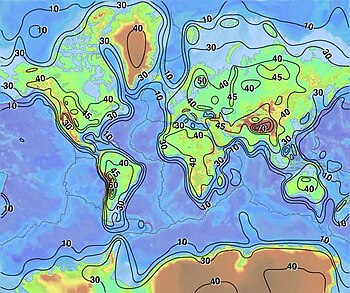Continental crust

The continental crust is the layer of granitic, sedimentary, and metamorphic rocks which form the continents and the areas of shallow seabed close to their shores, known as continental shelves.
It consists mostly of feldspar and other sialic rocks. It is less dense than the material of the Earth's mantle, which consists of mafic rock. Continental crust is also less dense than oceanic crust, though it is considerably thicker; mostly 35 to 40 km versus the average oceanic thickness of around 7–10 km. About 40% of the Earth's surface lies on-top of continental crust.
The continental crust is separated from the oceanic crust by the continental margin.
Related pages[change | change source]
References[change | change source]
- Butler, Rob, Making new continents Archived 2006-06-20 at the Wayback Machine Accessed 01/29/2006
- Saal, A.L., Rudnick R.L., Ravizza G.E. & Hart S.R., 1998. Re-Os isotope evdence for the composition, formation and age of the lower crust. Nature, 39317, 1998.
- Taylor and McLennan, 1995, Model of growth of continental crust through time in John Victor Walther, 2005, Essentials Of Geochemistry, Jones & Bartlett, ISBN 0-7637-2642-7
- von Huene, R. and D.W. Scholl, 1991. "Observations at convergent margins concerning sediment subduction, subduction erosion, and the growth of continental crust." Reviews of Geophysics, 29, 279-316.
Other websites[change | change source]
- Average composition of Continental Crust
- Crust 5.1 Archived 2008-09-08 at the Wayback Machine
